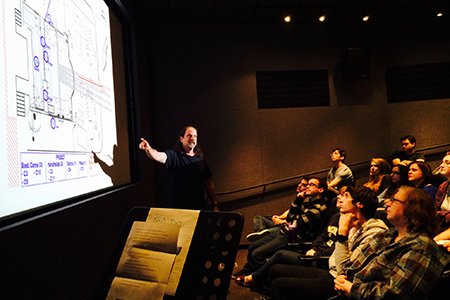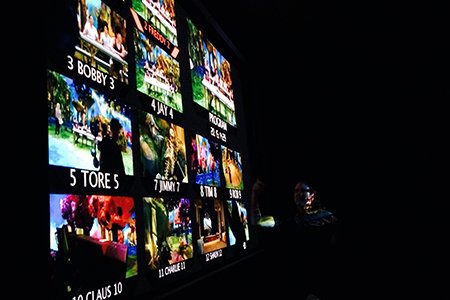Director Glenn Weiss of Peter Pan Live! visits ELA

Glenn Weiss of Peter Pan Live! (Photo by Daryl Paranada)
When most people think of Peter Pan, certain thoughts spring to mind, like Hook, Neverland, or Tinkerbell. When Glenn Weiss thinks about Peter Pan, he envisions camera angles, choreographing camera operators, and steady cams. That’s because Weiss, a veteran producer and director, recently co-directed NBC’s broadcast of Peter Pan Live!
An 11-time Emmy Award winner, Weiss came to Emerson College Los Angeles on January 21 to discuss the challenges of directing live television musicals.
“My vision of shooting Peter Pan was to be intimate,” said Weiss. “I wanted the viewers to come into this journey with us.”
To accomplish his goal, Weiss pushed for intimate set spaces and choreographed camera operators so that he could get tighter shots within four-walled rooms. On December 4, 2014, more than 9 million people tuned in to NBC to watch the event. Starring Allison Williams and Christopher Walken, Peter Pan Live! was produced on a $10 million budget. At least six Emerson alumni worked behind the scenes of the broadcast.

Greg Holstein ’07 was among the alumni who showed up to get insight on live TV productions from Weiss.
“I don’t know much about live television,” said Holstein. “I’m a producer myself and I’m curious to learn more.”
Weiss, a close friend of Emerson College, spent the evening telling the audience about how Peter Pan Live! went from script to the small screen. One word that he brought up consistently: compromise.
“It’s so important in this business to understand that at the end of the day, there’s compromise,” said Weiss.
For example, at the beginning of Peter Pan Live! Weiss wanted to include a sweeping shot of London. To keep the London set from going over budget, the crew erected scenery of London and used smoke and fog to hide gaps.
Other tidbits he shared with the audience: he once wanted Tinkerbell to be a drone (it ended up being live CGI); he created the “camera bible” for most of the show on four flights between Los Angeles and New York; and the flying scenes were among the most difficult to shoot.
At the end of the evening, Weiss shared two things that he has obsessed over since the broadcast. The first happened during the musical number “I Won’t Grow Up,” when he cut from one wide shot to another (a camera operator was on the wrong shot). The second involved the last act of the television musical, when one of his camera operators lost control of a camera. Weiss said he had to go off-script and call shots based on what he was seeing in live time.

“It was like directing air traffic control,” he said, reiterating his point of why it’s important for any director to know the material inside and out.
Weiss’s story about reacting to the situation stuck with Ruby Zhang ’15, a Visual and Media Arts major.
“You have to be prepared for any situation,” said Zhang. “It was really great to find out more about the directing process.”
The merging of theater and television is something that Weiss and many students hope will continue. That’s one of the reasons that Michael Doppel ’15, a Visual and Media Arts major, attended the discussion.
“It feels like it could be a new trend,” said Doppel.
Asked for advice that he might give to folks hoping to follow in his footsteps, Weiss said it was important for students to take in everything that they can.
“The best directors are the ones who have experienced several other positions,” said Weiss. “Therefore, when they give instructions, they can understand what they’re asking for.”
Categories